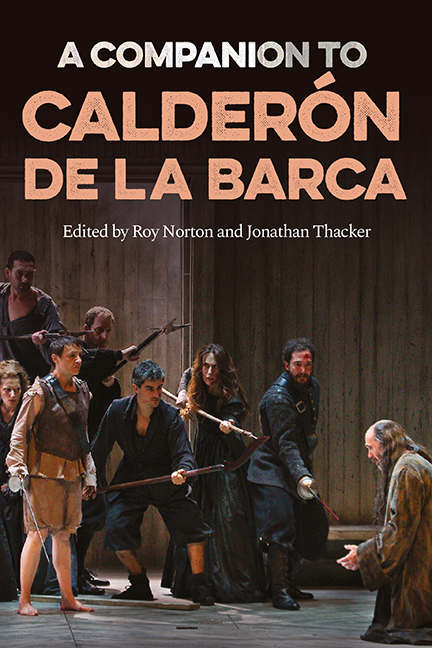Book contents
- Frontmatter
- Dedication
- Contents
- List of Illustrations
- List of Contributors
- Acknowledgements
- List of Abbreviations
- Introduction
- 1 Biography and Context
- 2 The Calderonian World
- 3 The Playwright’s Craft: Calderón and the Great Theatrical World of Early Modern Spain
- 4 La vida es sueño
- 5 The Honour Plays of Calderón
- 6 Calderón, the Comedian
- 7 Mythological Court Spectacle Plays
- 8 Religious comedias
- 9 Calderón’s ‘Sacramental, Allegorical and Historical’ autos
- 10 Calderón’s graciosos
- 11 Calderón and Visual Art
- 12 The Staging of Calderón’s Theatre
- 13 Calderón’s European Reception from Romanticism to the Twentieth Century
- 14 The Reception of Calderón in the Hispanic World
- Appendices
- Consolidated Bibliography
- Index
- Tamesis • Companions
9 - Calderón’s ‘Sacramental, Allegorical and Historical’ autos
Published online by Cambridge University Press: 07 October 2022
- Frontmatter
- Dedication
- Contents
- List of Illustrations
- List of Contributors
- Acknowledgements
- List of Abbreviations
- Introduction
- 1 Biography and Context
- 2 The Calderonian World
- 3 The Playwright’s Craft: Calderón and the Great Theatrical World of Early Modern Spain
- 4 La vida es sueño
- 5 The Honour Plays of Calderón
- 6 Calderón, the Comedian
- 7 Mythological Court Spectacle Plays
- 8 Religious comedias
- 9 Calderón’s ‘Sacramental, Allegorical and Historical’ autos
- 10 Calderón’s graciosos
- 11 Calderón and Visual Art
- 12 The Staging of Calderón’s Theatre
- 13 Calderón’s European Reception from Romanticism to the Twentieth Century
- 14 The Reception of Calderón in the Hispanic World
- Appendices
- Consolidated Bibliography
- Index
- Tamesis • Companions
Summary
THE AUTO SACRAMENTAL AND ITS CONTEXT – THE EUCHARIST
Calderón's autos sacramentales [one-act sacramental plays] have diverse functions – some essential, some secondary – that vary from one play to the next, sometimes reflecting the concrete historical and political circumstances from which each emerged. These precise circumstances should be borne in mind when an auto is interpreted; the core purpose of this seventeenth-century dramatic genre is clear, however, from the play-texts themselves, and from the plays’ performance within a fixed, specific context – the Feast of Corpus Christi. The auto sacramental formed part of a series of festive liturgical celebrations and can be defined as a type of religious play that promotes the exaltation of one of Catholic Christianity's most important sacra-ments, the Eucharist, and in particular the doctrine of Transubstantiation, according to which bread and wine becomes the body and blood of Christ.
That is not to say that the Eucharist is the auto's exclusive theme or that the presence of the sacrament is explicit in every text. Even in autos where the Eucharist does not have an extensive, dominant presence, however, or in those where its appearance is limited to the final apotheosis, it is always observable from the perspective of human redemption and allied notions such as original sin, good and evil, and Christ's redemptive sacrifice, for instance. In Catholic theology this theme of human redemption is inseparable from the institution of the sacrament of the Eucharist, which represents in unbloody form the sacrifice of Calvary. The auto sacramental is always situated in the realm of salvation history, even though its plots are taken from a wide variety of sources, including some far removed from the religious world of Spain's Golden Age. The connection between this central theme of the Eucharist (or of salvation history) and the autos’ varied plots can be understood with reference to the distinction between the asunto [theme] and the argumento [plot] that the playwright himself advances in the preface to his Autos sacramentales alegóricos y historiales [Sacramental, Allegorical and Historical autos], published in Madrid in 1677, the only collection of Calderón's autos published during his lifetime and with his authorisation.
- Type
- Chapter
- Information
- A Companion to Calderón de la Barca , pp. 172 - 198Publisher: Boydell & BrewerPrint publication year: 2021

